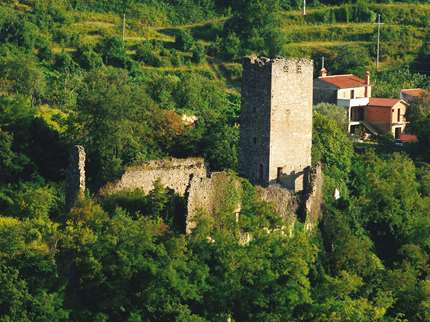Return
The Momjan Castle
Only a ruin today, the Momjan castle is located above the Dragonja river. It is known as the Rota castle after the Rota family who owned it for several hundred years.
The Momjan castle, presently dilapidated and ivy-grown, can hardly evoke the power and wealth of the life that characterized it. It was built above the abyss overlooking the Dragonja River, today a border between Croatia and Slovenia. Located at 280 meters above the sea level, it dominates the Dragonja valley, divided from it by the Poganja brook. Momjan was first mentioned in 1035. The Patriarch of Aquileia was given a rule over it by the deed of gift in 1102. The erection of the fortress began in the first half of the 13th century, when it was given by the Patriarch to the Counts of Devin. The owners of Momjan, the family of Woscalc from Devin and sons, were known for their fickleness and expressed their affiliation depending on interests. Fitting nicely into this feature was their constant desire to gain political functions. They were known for their disputes and conflicts with neighbours, and often fought and changed sides between the Counts of Gorizia and Patriarchs of Aquileia. Almost a cursed town, it constantly changed owners, the property was mortgaged, returned, but always important and mentioned. Thus, it was ruled by the regents appointed by Pietrapelosa and the Counts of Gorizia. In 1548, the castle was bought by Simone Rota, of the Rota family from Bergamo, who moved to Piran just before purchasing it. Rota gave the castle the trapezoid shape with a square tower, which was renovated as residential quarters. It erected the chapel of St. Stephen and built a new stone bridge. Until it was abandoned in 1835, the castle had a residential function, after which it fell into decay as the Counts of Rota moved to a more comfortable palace in the village. As the castle was long owned by the Rota family, it is known today as the Rota Castle. Only the ruins of the castle remained as reminder of the Momjan's glorious past.







